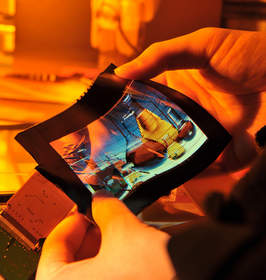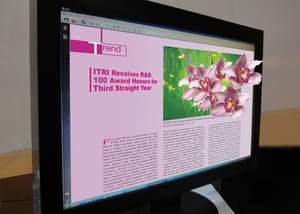HSINCHU, TAIWAN--(Marketwire - October 27, 2010) - ITRI (Industrial Technology Research Institute), Taiwan's largest and one of the world's leading high-tech research and development institutions, introduces FlexUPD, the first technology to enable the commercialization of paper-thin, low-cost flexible flat displays for electronic products, and i2/3DW, an innovative technology to integrate 2D and 3D information for simultaneous display on the same screen visible to the naked eye. ITRI will receive the Overall Gold Wall Street Journal Technology Innovation Award for FlexUPD next week and a "2010 R&D 100 Award" from R&D Magazine in November for both breakthrough technologies.
ITRI's FlexUPD ushers in a new generation of flexible electronics. It is the simplest and most inexpensive technology to allow for the mass manufacture of paper-like, flexible flat panel displays thinner than any displays currently on the market. This flexibility allows for two-sided surface visibility for display or non-display products -- rollable mobile phone screens, e-books, e-maps and medical sensors that can be worn or wrapped around the body, etc. -- to be light, malleable and unbreakable.
"We are on the cusp of a new era of flexible displays," said Dr. John Chen, general director of ITRI's Display Technology Center. "FlexUPD's universal backplane technology allows for many applications to be created, which will go beyond our current imagination. The impact will only be realized as they emerge. FlexUPD will transform visualization as we know it."
Commercialization of the FlexUPD is currently underway. AU Optronics Corp. (AUO) plans to commercially release a line of flexible e-reader products very soon. The technology is available for transfer to companies worldwide.
The key breakthrough in FlexUPD is its simultaneous adhesive and non-adhesive bonding -- the use of a "de-bonding layer" -- between the glass and flexible substrate. The de-bonding layer -- inspired by Taiwan crepe-making techniques -- sticks to the production glass substrate firmly during the entire fabrication process and is completely non-adhesive to the polyimide (PI) film stacked on top during this phase -- much like a layer of non-stick material separating the crepe from the pan. This allows the indispensable active matrix backplane for high-quality color displays to be flexible.
FlexUPD is easily adaptable by panel and display manufacturers and technologically is compatible with mainstream LCD production lines operating now and in the future, and is even compatible with old generations of LCD makers -- manufacturers must only add the de-bonding equipment to incorporate the FlexUPD.
ITRI's award-winning i2/3DW is a next generation 2D/3D switchable display technology that is the first to fully and simultaneously integrate 3D displays for the naked eye with traditional 2D information. This breakthrough solves the problems previously associated with 2D/3D displays -- a lack of integration forcing viewers to switch between 2D and 3D modes -- and 3D displays -- blurry text and specific eyewear. With i2/3DW, 2D texts are as clear as they are on a 2D screen and 3D images are as fascinating as on a 3D screen, but can now coexist on the same screen for optimal viewing quality.
"We are at the brink of the new 3D generation," said Stephen Jeng, ITRI's division director of Electronics and Optoelectronics. "With the rise of 3D technology in the entertainment, video game, mobile device and medical industries, and in Internet applications, ITRI's i2/3DW will revolutionize displays, catapulting them into the 3D era. It will change the way people watch TV and use computers, and is also designed for specialty applications such as endoscopic surgery, digital signage, remote medical care and e-books, among others."
The construction of an enabled i2/3DW display is comprised of three primary component layers: the conventional liquid crystal display panel (LCD panel), the dynamic black-light unit (DBLU) and the 2D/3D switching layer -- that lies in between the LCD and DBLU panels, allowing the 2D and 3D display mode to be switched automatically. This feature differentiates ITRI's i2/3DW technology from its competitors -- to date, similar technologies have only focused on whole screen 2D or 3D display. i2/3DW is the first to make the integration of a partial switch possible. ITRI's switching component is made of two polarization films, one microretarder and one low-resolution LC panel -- all extremely inexpensive to make, making the i2/3DW technology affordable.
The i2/3DW could reenergize the struggling panel and display market. Prices of LCDs used in computers and TVs fell 7.8 percent in the third quarter of 2010 for a major manufacturer.1 The i2/3DW could revitalize the industry by revolutionizing the concept of 3D viewing.
ITRI has applied for 62 patents for FlexUPD and 11 patents for i2/3DW, and is currently licensing both technologies. Interested companies can contact ITRI at 1-408-428-9988 or 0800@itri.org.tw for more information.
ITRI, headquartered in Taiwan, has offices in the United States, Japan, Russia and Germany in an effort to extend its R&D scope and promote opportunities for international cooperation. In the U.S., it has long-term collaborative arrangements with MIT, Carnegie Mellon University, the University of California at Berkeley and Stanford University. Globally, it has 23 international cooperations with major companies such as IBM, HP, Microsoft, Nokia, Sun Microsystems, Kodak, Lucent and Motorola.
To date, ITRI holds more than 14,571 patents and has assisted in the creation of more than 163 start-ups and spin-offs. In 2010, the institute has received five prestigious international awards: The Overall Gold Wall Street Journal Technology Innovation Award for its FlexUPD technology, runner-up in the Semiconductor category for its MDPS (Micro-Deformable Piezoresistive Sensor Technology) and three R&D 100 Awards for FlexUPD, i2/3DW and Reddex. In 2009, the institute also received four prestigious international awards: The Wall Street Journal's 2009 Technology Innovation Award for its FleXpeaker technology, an R&D 100 Award for the High Safety STOBA Lithium Battery Material Technology, the iF Design Award from the International Forum Design in Germany for ITRA's Fluid Driven Lighting System, and the Red Dot Design Award by the Design Zentrum Nordrhein Westfalen in Essen, Germany, for its Flexio Radio Technology.
1 Bloomberg.com, http://www.bloomberg.com/news/2010-10-06/samsung-profit-misses-estimates-as-prices-of-chips-flat-screens-decline.html October 15, 2010
About ITRI (www.itri.org.tw/eng)
Industrial Technology Research Institute (ITRI) is a nonprofit R&D organization engaging in applied research and technical services. Founded in 1973, ITRI has played a vital role in transforming Taiwan's economy from a labor-intensive industry to a high-tech industry. Numerous well-known, high-tech companies in Taiwan, such as leaders in the semiconductor industry TSMC and UMC, can trace their origins to ITRI.
Innovative Research
ITRI is a multidisciplinary research center, with six core laboratories, three focus centers, five linkage centers, several leading labs and various business development units. The six fields ITRI focuses on include Information and Communication; Electronics and Optoelectronics; Material, Chemical and Nanotechnologies; Biomedical Technologies and Device; Advanced Manufacturing and Systems; and Green Energy and Environment. ITRI has aggressively researched and developed countless next-generation technologies, including WIMAX wireless broadband, solar cells, RFID, light electric vehicles, flexible displays, 3-D ICs and telecare technologies. In addition, ITRI's Flexible Electronics Pilot Lab and Nanotechnology Lab provide international-level research platforms where R&D can be conducted jointly with partners. ITRI has also seen significant growth in intellectual property business and new ventures in recent years and is devoted to creating a model that would make Taiwan manufacturing even more competitive in the international arena.
Fostering Entrepreneurship and CEO Leadership
ITRI employs 5,728 personnel, including 1,163 who hold Ph.D.s and 3,152 with master's degrees, resulting in an average of five patents produced every day. By disseminating both technology and talent, ITRI has led the technology industry into the 21st century and has cultivated 70 CEOs in the local high-tech industry. In addition to its headquarters in Taiwan, ITRI has branch offices in the California Silicon Valley, Tokyo, Berlin and Moscow.
Contact Information:
Media Contact:
Adam Landres-Schnur/Alexandra Pony
Graham & Associates
(415) 986-7212

